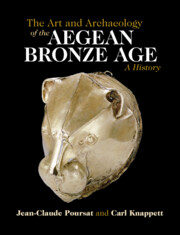Book contents
- The Art and Archaeology of the Aegean Bronze Age
- The Art and Archaeology of the Aegean Bronze Age
- Copyright page
- Contents
- Figures
- Introduction
- Part I Aegean Neolithic Art
- Part II The Art of the Aegean Early Bronze Age
- Part III Aegean Art in the Cretan First Palace Period
- Part IV Aegean Art in the Second Palace Period
- Part V Aegean Art in the Cretan Second Palace Period
- Part VI Aegean Art in the Final Palatial Period of Knossos
- Part VII Aegean Art of the Mainland Mycenaean Palatial Period
- Part VIII Aegean Art at the End of the Bronze Age
- Afterword Aegean Art Through Forgers’ Eyes
- Chapter 56 Fakes and Dubitanda
- References
- Index
- Plate Section (PDF Only)
- References
Chapter 56 - Fakes and Dubitanda
from Afterword - Aegean Art Through Forgers’ Eyes
Published online by Cambridge University Press: 19 May 2022
- The Art and Archaeology of the Aegean Bronze Age
- The Art and Archaeology of the Aegean Bronze Age
- Copyright page
- Contents
- Figures
- Introduction
- Part I Aegean Neolithic Art
- Part II The Art of the Aegean Early Bronze Age
- Part III Aegean Art in the Cretan First Palace Period
- Part IV Aegean Art in the Second Palace Period
- Part V Aegean Art in the Cretan Second Palace Period
- Part VI Aegean Art in the Final Palatial Period of Knossos
- Part VII Aegean Art of the Mainland Mycenaean Palatial Period
- Part VIII Aegean Art at the End of the Bronze Age
- Afterword Aegean Art Through Forgers’ Eyes
- Chapter 56 Fakes and Dubitanda
- References
- Index
- Plate Section (PDF Only)
- References
Summary
Forgers of antiquities have been active across all domains of archaeology ever since artefacts unearthed through excavation, whether legal or illegal, generated publicity and attained significant market value. This happened very rapidly in the case of Aegean art (H.-G. Buchholz, Acta Praehistorica et Archaeologica 1, 113–35). Very shortly after Schliemann’s excavations at Mycenae, from 1883, reports appeared of a workshop making fake Mycenaean signet rings in the Peloponnese (Milchhöfer 1883, 59, n. 1). Evans’s work at Knossos from 1900 gave a major boost to the manufacture of fake Minoan antiquities.
Such discoveries took place in conditions especially favourable to forgery. The looting in Greece and Turkey of Hellenistic cemeteries at Tanagra (near Thebes in Boeotia) and at Myrina (near Izmir) released numerous terracotta figurines (the ‘Tanagras’) onto the market from the 1880s onwards. Several workshops made multiple copies, especially on Crete.
- Type
- Chapter
- Information
- The Art and Archaeology of the Aegean Bronze AgeA History, pp. 523 - 530Publisher: Cambridge University PressPrint publication year: 2022

